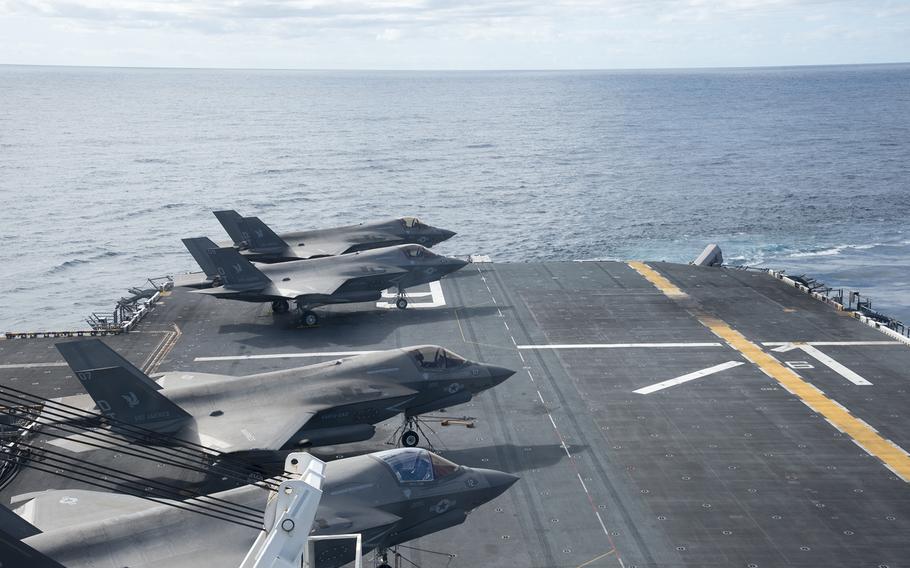
F-35B Lightning II stealth fighters pack the USS America's flight deck in the Coral Sea, July 31, 2023. (Kelly Agee/Stars and Stripes)
Flat decks from the United States, Japan and Australia will train together this week off the western coast of the Philippines in the South China Sea, according to Philippine security officials.
The exercise involving ships that carry helicopters and F-35 fighters will show the three nations’ commitment to the rule of law in the region after recent Chinese aggression in disputed waters, two officials speaking on condition of anonymity told The Associated Press on Sunday.
China’s coast guard on Aug. 5 fired water cannons at civilian vessels taking food, water, fuel and other supplies to Philippine forces stationed at the Second Thomas Shoal, a disputed feature in the South China Sea.
The flat deck drill, planned months ago, will involve the amphibious assault ship USS America, the helicopter destroyer JS Izumo and the helicopter landing dock HMAS Canberra. The warships’ commanders will meet their Filipino counterparts in Manila after the drills, according to AP.
The Philippines is not taking part in the exercise due to logistical limitations but could join future drills, AP reported.
“The precipitating event for the exercise is the aggressive [Chinese] Coast Guard behavior towards unarmed Filipino boats in close proximity to Philippine territorial waters,” Paul Buchanan, a New Zealand-based U.S. security expert, said by email Monday.
China coast guard vessels turned high-pressured water hoses on one of two military-chartered civilian vessels, escorted by two Philippine coast guard ships, as they attempted to move supplies to troops on Second Thomas Shoal in the Spratly Islands. Eight Chinese vessels attempted to block their way, according to Philippines authorities.
The water cannon incident and similar close encounters are seen as part of an intimidation campaign designed to hinder freedom of navigation by Philippine boats, Buchanan said.
“The answer to that sort of bullying behavior is to bring a bigger player into the equation, and a US carrier with Japanese and Australian maritime helicopter platforms is a good pick for that role,” he said.
The drills are a sign of more robust allied support for Southeast Asian friends and a response to “Beijing's continuing attempted coercion of the Philippines, in particular,” Ross Babbage, a former Australian assistant defense secretary, said by email Monday.
Defense ties have strengthened with the U.S., Japan and Australia under the administration of Philippine President Ferdinand Marcos Jr., according to Ian Chong, an associate professor of political science at the National University of Singapore.
The U.S., Australia and Japan are strengthening their own military ties while Japan is becoming increasingly willing to safeguard its interests in the South China Sea, he said by email Monday.
Meanwhile, China is making stronger efforts to press its maritime claims from the East China Sea through Taiwan and the South China Sea, Chong said.
China is undertaking “more frequent and larger scale military exercises, robust patrolling around areas it claims, and what the United States, Philippines, Australia and others have called unsafe and unprofessional conduct in the air and at sea,” he said.